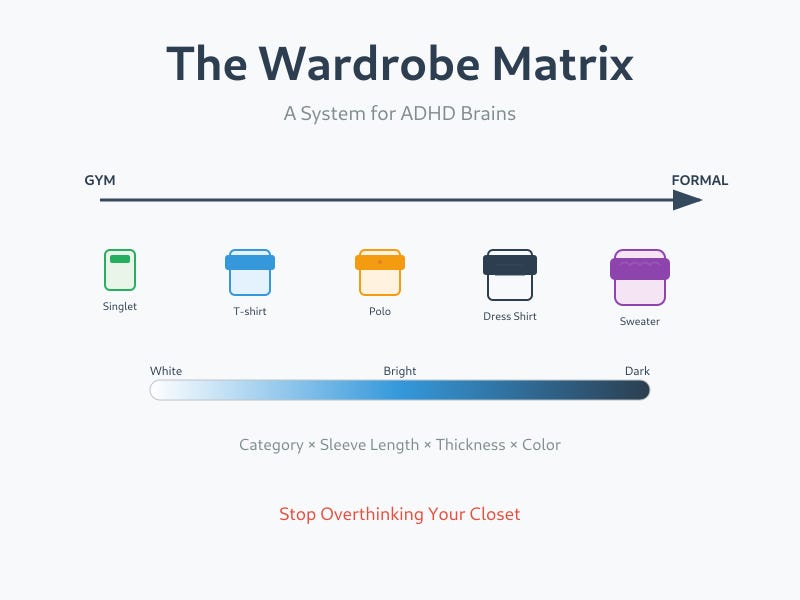The Wardrobe Matrix
A System for ADHD Brains That Hate Deciding What to Wear
If you have ADHD, you know the feeling. You're standing in front of your closet, running late, trying to figure out what goes with what. Or you're doing laundry and can't remember where things go. Every time feels like starting from scratch.
The problem isn't that you don't have clothes. It's that every clothing decision requires active thinking. Your brain has to process formality levels, color matching, weather, and social context—all before you've had coffee. Then you do it again when putting laundry away.
What Problem Is This Solving?
I remember before I thought up this system—sometimes it took me so long doing laundry, especially thinking about where everything should go, that it often wasn't worth doing it. Literally. I felt like I was inventing a new system of organisation every time I did laundry. It was exhausting.
Most of the time clothes would end up staying on drying racks, then they'd transition to the couch or half and half or even more spread out. Which was even worse, because I didn't know where anything was at a given time.
I timed myself at one point and realised I was spending an absurd amount of time simply putting away clothes. When I said it to myself like that I knew I had to figure out a better way.
The Basic Framework
Think of your wardrobe as a spectrum running left to right. On the far left you've got active wear and gym clothes. On the far right, formal wear and sweaters. Everything else falls somewhere in between.
For men, the categories break down like this:
Active wear/gym (far left)
Casual
Semi-formal (polo shirts, etc.)
Formal
Workwear
Sweaters (far right)
For women, it's similar but includes dresses:
Active wear/gym (far left)
Casual
Semi-formal
Formal
Dresses
Workwear (optional)
Sweaters (far right)
Within Each Category
Every category gets subdivided by three factors:
Sleeve length
Thickness
Color (white, bright, dark)
This creates a grid. A white singlet sits on the far left. A black sweater sits on the far right. Everything else has a specific position based on these three variables.
How the System Actually Works
The key insight is that items flow into each other logically, but they don't need exact positions. When you're sorting by color, you're looking at "average color tone" - which means a shirt might sit in slightly different spots depending on how you see it that day.
The priority works like this:
Category: gym → casual → dress clothes
↓
Sleeves: singlet → short-sleeve → long-sleeve
↓
Thickness: thin → thick
↓
Color: white → bright → dark
Here's an example of my thought process working through some random clothes: Blue singlet → black singlet with writing/pattern → black singlet → thin black t-shirt → thick black/white pattern t-shirt → thin green long-sleeve t-shirt → thick green long-sleeve t-shirt → thick black long-sleeve t-shirt.
The Color Profiling Trick
Judging color becomes subjective and will depend on your interpretation. For now just imagine that white is plain white with no other colors or patterns, and dark is plain black with no other colors or patterns.
When you move away from white toward bright, imagine the overall/average color palette—pretend any words/patterns, the overall color is all combined into a single color. A black t-shirt with white writing would become a dark grey profile—specifically dark grey because there's more black than white.
How you think about this will vary each time you do laundry—and that's the best part, it doesn't matter. It's enough for your brain to have a system to work with, gives you a repeatable process with basic enough rules.
Think Through All Combinations
Once you map your wardrobe this way, decisions become automatic. You're not actively choosing—you're following a system that's already in your head.
Doing laundry? Each item has a general place in the matrix. Getting dressed? You know roughly where each item sits on the formality spectrum. The cognitive load disappears because you're not making fresh decisions every time.
Why This Flexibility Matters for ADHD
There's a lot of subjectivity in the organizing categories, which is great because it takes away the pressure for it to be perfect. As long as it's "about right" then it is perfect.
The great thing about this system is its flexibility and modularity, so you can switch parts around. Your ADHD brain doesn't have to memorize where exactly 47 different pieces go. It just needs to remember the general pattern: lighter colors flow to darker colors, casual flows to formal.
The deciding is already done and it provides enough novelty whereby you get creative output so at the same time it's not too boring/monotonous.
Executive function challenges make simple tasks complicated. This system works because it eliminates the need to actively process clothing decisions. The framework runs in the background, like muscle memory for your wardrobe.
The Bottom Line
It doesn't need to be perfect. In fact, it shouldn't be. If you're trying to make it perfect you're overthinking it. Relax and remember the point is to get your clothes put away without decision fatigue or analysis paralysis.
You stop overthinking your clothes and start using them. The daily "what goes with what" becomes automatic, freeing up mental energy for things that actually matter.



